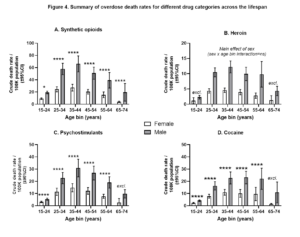 Hot Off the Press – June 22, 2023
Hot Off the Press – June 22, 2023
A new collaborative study coauthored by investigators from Mount Sinai School of Medicine, NIDA-IRP, and NIDA-HQ showed that fatal overdoses on opioids or psychostimulants are 2-3 times more common in men than in women. This sex difference is far larger than those seen in most health-related behaviors. It is not accounted for by smaller sex differences in rates of use or misuse of those drug classes, and it is similar in all US states, suggesting that it reflects a fundamental difference in the way men and woman are using or responding to the drugs.
Publication Information
Overdose mortality rates for opioids and stimulant drugs are substantially higher in men than in women: state-level analysis Journal Article
In: Neuropsychopharmacology, 2023.
